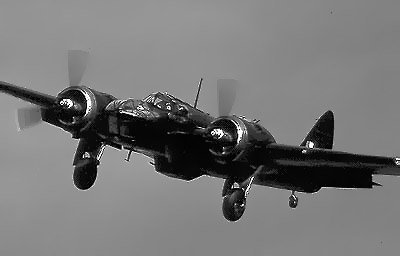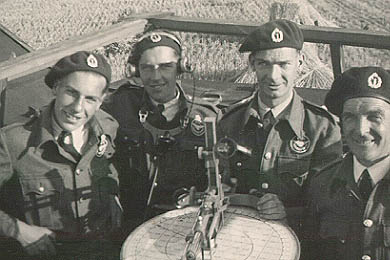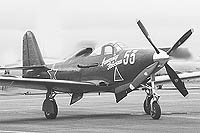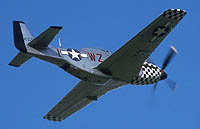Part One: The Early Years, 1939 to 1950 by Dave Eade
Thankfully, before I was born, Wattisham as we know it rose from the realisation by the powers-that-were in the thirties that, like it or not, things were going to get worse in Europe before they got better. With horrible similarity to today, those who saw no likelihood of confrontation in the Europe after the Great War had accomplished the unforgivable task of reducing our armed forces to a mere shadow of their former selves. Some may say, with justification, it was almost criminal in the light of the sacrifice paid by our soldiers in the 1914-18 conflict to find this country so ill-equipped for a further conflict that would tear Europe apart.Sense finally prevailed in the mid-thirties and a rapid expansion of our forces began. Factories were put to work to try to bring our separate military commands up-to-date. Rapidly, land was acquired in the east of the country, amongst that being three farms in the village of Wattisham, near Stowmarket in Suffolk. These farms were totally removed in the creation of a light bomber station, equipped with four large C-type hangars and a grass runway.
 Wing
Commander O. R. Gayford officially took over the new station on 6 April
1939 and immediately two squadrons of Bristol Blenheims, 107 and 110,
took up residence. Ipswich Airport, newly opened in the late thirties,
became a satellite of Wattisham, (one of the earliest examples of dispersal,
I suppose). It was from here, on 4 September 1939, the first day proper
of the War, that the first bombing raid took place, and the first of many
losses that were to befall the Blenheim units. Four aircraft were lost
from 107 Squadron and one from 110
Squadron as German battleships near Wilhelmshaven were attacked; one
of the Blenheims crashing on the foredeck of the cruiser 'Emden'. For
his part in leading the attack, Flt Lt Doran was awarded the D.F.C., the
first decoration to be awarded in the Second World War.
Wing
Commander O. R. Gayford officially took over the new station on 6 April
1939 and immediately two squadrons of Bristol Blenheims, 107 and 110,
took up residence. Ipswich Airport, newly opened in the late thirties,
became a satellite of Wattisham, (one of the earliest examples of dispersal,
I suppose). It was from here, on 4 September 1939, the first day proper
of the War, that the first bombing raid took place, and the first of many
losses that were to befall the Blenheim units. Four aircraft were lost
from 107 Squadron and one from 110
Squadron as German battleships near Wilhelmshaven were attacked; one
of the Blenheims crashing on the foredeck of the cruiser 'Emden'. For
his part in leading the attack, Flt Lt Doran was awarded the D.F.C., the
first decoration to be awarded in the Second World War.
Throughout the remainder of '39 and for the most of 1940 the two squadrons made attacks by night and day on a variety of targets, including U-boats, one of which was sunk by a plane from 107. Wattisham was subject to a number of raids in this period, with much damage to hangars and buildings and the loss of several airmen. In an effort to protect the airfield Hurricanes of 504 Squadron were detached from Debden for a short while.
107 Squadron moved out in May 1941 to be replaced by 226 Squadron, which in turn was replaced in December by 18 Squadron, still flying the Blenheim. 236 Squadron, equipped with the newer and more capable Beaufighter, arrived in February 1942 to replace 110 Squadron, who were moving on to the Far East. Soon, on 12 June, another piece of Second World War folk-lore was about to be written, the story of the French tricolour being thrown out of a low-flying aircraft while flying over the Arc de Triomphe is well known and the aircraft, T4800 from 236 Squadron and flown by Flt Lt Gatwood, then continued to strafe the Gestapo HQ in Paris before running for the English coast.
Like its fellow bases, by being there Wattisham became a target for the Luftwaffe, and was attacked on many occasions. Barrack blocks and two of the hangers received hits. Houses in the nearby village of Battisford still bear the bullet marks of strafing fighters, and Stowmarket itself was also hit. A lone raider, caught by defending fighters or AA guns released his bomb-load off-target, in an attempt to lighten the plane enough to get home. The package of high explosives found as their target the Congregational chapel in the main street of the town, reducing it to a pile of rubble. The miracle of this event was that, when the siren sounded during the normal day, shoppers were known to take shelter in the chapel from the air-raid. On this occasion mercifully nobody was in the chapel.
A glance at the bungalows in both Hillside and Poplar Hill, not far from the Combs Ford area of Stowmarket, shows even today new brickwork where two were re-built after being hit by loose bombs falling off their target. It’s a thought that today, where we can decide which window a smart bomb should use to gain access, these bombs were at least three miles off-target.
 My
late father, being a driver for the local milk-distributors in Stowmarket,
was spared call-up, as the major part of their efforts was to supply London.
He joined the then Observer Corps and positioned in Combs, at the top
of Poplar Hill, reported raiders on the nearby airfield to the Centre
from which fighters would be controlled. Those with knowledge of this
area will remember well the 'post' as it was known, situated in what was
referred to as the 'Hundred-Acre field'. Their greatest moment of glory
came when a Junkers 88 crash-landed into the field, and they had to arrest
and hold the crew until the authorities arrived. Their worst moment was
when a formation of the 'Mighty Eighth' returned from a raid to their
base at Mendlesham, accompanied in the formation by Luftwaffe fighters.
Desperate reports from the Corps posts were greeted with disbelief, and
assumed to be bad aircraft recognition. As the bombers broke formation,
they became easy targets for the marauding pack. This action, believed
to be at dusk on 7 June 1944, caused four B-24 Liberators of the 34th
Bomb Group to be lost to Me410s. One B-24 crashed into an equipment store
on the airfield, destroying parachutes, oxygen masks and heated suits.
Many B-24s fled to other airfields to escape the carnage and one Me410
was claimed by night fighters, but subsequently the air gunners aboard
the bombers were somewhat more alert.
My
late father, being a driver for the local milk-distributors in Stowmarket,
was spared call-up, as the major part of their efforts was to supply London.
He joined the then Observer Corps and positioned in Combs, at the top
of Poplar Hill, reported raiders on the nearby airfield to the Centre
from which fighters would be controlled. Those with knowledge of this
area will remember well the 'post' as it was known, situated in what was
referred to as the 'Hundred-Acre field'. Their greatest moment of glory
came when a Junkers 88 crash-landed into the field, and they had to arrest
and hold the crew until the authorities arrived. Their worst moment was
when a formation of the 'Mighty Eighth' returned from a raid to their
base at Mendlesham, accompanied in the formation by Luftwaffe fighters.
Desperate reports from the Corps posts were greeted with disbelief, and
assumed to be bad aircraft recognition. As the bombers broke formation,
they became easy targets for the marauding pack. This action, believed
to be at dusk on 7 June 1944, caused four B-24 Liberators of the 34th
Bomb Group to be lost to Me410s. One B-24 crashed into an equipment store
on the airfield, destroying parachutes, oxygen masks and heated suits.
Many B-24s fled to other airfields to escape the carnage and one Me410
was claimed by night fighters, but subsequently the air gunners aboard
the bombers were somewhat more alert.
 If
the reader will forgive a small digression, the men like my father, who
worked long days, driving tankers into the blitz, to return to their homes
and put in a full shift with organisations like the Observer Corps, Home
Guard, etc. are forgotten people. Their efforts, however, enabled the
crippled cities to feed their people with fresh milk, and farm produce.
Their spare time efforts gave the RAF and AA batteries the picture that
was necessary to plan the defence of this island.
If
the reader will forgive a small digression, the men like my father, who
worked long days, driving tankers into the blitz, to return to their homes
and put in a full shift with organisations like the Observer Corps, Home
Guard, etc. are forgotten people. Their efforts, however, enabled the
crippled cities to feed their people with fresh milk, and farm produce.
Their spare time efforts gave the RAF and AA batteries the picture that
was necessary to plan the defence of this island.
The RAF vacated Wattisham in September
1942 and plans were in place to create a bomber base, complete with concrete
runways, for the USAF. In 1942 the
airfield was handed over to the United States Army Air Force, new runways
and buildings were installed and the bombers awaited. The 12th
AF first arrived on 12 September 1942, the base being given the  US
station number 377, the first occupied in the UK by the 12th.
Two squadrons of the 68th Observation Group took up residence
equipped with P-39D Airacobras, but left for North Africa in the December.
Next, from 1942 to 1944 the base was a USAAF Air Depot, the 4th
Strategic AD being based on what would become 56 Squadron's HAS area (known
in the war as Hitcham AD).
US
station number 377, the first occupied in the UK by the 12th.
Two squadrons of the 68th Observation Group took up residence
equipped with P-39D Airacobras, but left for North Africa in the December.
Next, from 1942 to 1944 the base was a USAAF Air Depot, the 4th
Strategic AD being based on what would become 56 Squadron's HAS area (known
in the war as Hitcham AD).
1944 dawned and Wattisham became part of
the 8th Air Force. The 479th FG under the 8th AF
command, comprising the 434th, 435th & 436th
FS with P-38Js initially and later P-51Ds, arriving at Wattisham on 15
May 1944. Led by Lt Col H.L. Riddle, they were known as 'Riddle's Raiders'
and the last Fighter Group to join the Mighty Eighth. The sight and sound
of the based Lightnings soon became commonplace and in August 1944 Lt
Col Riddle went missing in action, but evaded capture and made his way
back to the UK to re-take command of the Group in the November as Colonel.
By then they had converted to the Mustang, under the temporary control
of Col Hubert Zemke, who was previously with the 56th FG, but
in the October was also shot down and captured, spending the rest of the
war as a POW. The Group, the last fighter unit to be stood down at the
end of hostilities, left the UK in November 1945 after 351 missions, being
the first to  claim
combat with jet aircraft in July 1944 and the last enemy to be downed
by the Eighth on 25 April 1945. It also earned two Distinguished Unit
Citations for attacks on French airfields in August 1944 and combat during
a raid on Munster in the September.
claim
combat with jet aircraft in July 1944 and the last enemy to be downed
by the Eighth on 25 April 1945. It also earned two Distinguished Unit
Citations for attacks on French airfields in August 1944 and combat during
a raid on Munster in the September.
Wattisham was handed back to the RAF in January 1946, one of few permanent stations to be occupied by the Americans. With its extensive hangarage, runways and domestic accommodation the station was selected for peace-time operations by the much reduced air force, and after some refurbishment in the October the first post-war squadron moved in, being 245 Squadron equipped with Meteor F3s; this leads me into the fifties and more personal recollections, commencing with the Meteor - see part two.